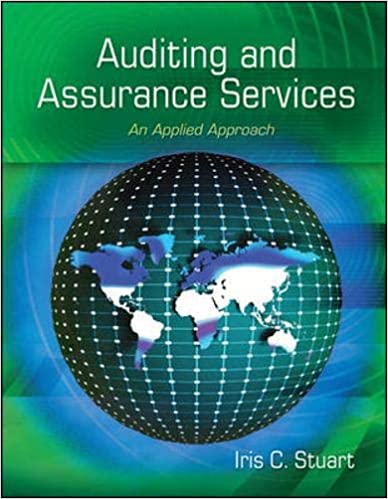
Auditing and Assurance Services 1st Edition by Iris Stuart
Edition 1ISBN: 978-0073404004
Auditing and Assurance Services 1st Edition by Iris Stuart
Edition 1ISBN: 978-0073404004 Exercise 1
Describe management's assertions regarding the financial statements.
Explanation
Financial statement:
The financial statement is the statement of the company position at a particular time period.
Every company prepares two types of financial statement:
1. Income statement (Profit and loss statement)
2. Balance Sheet
Income Statement:
The income statement is the statement of revenue and expenses which provide us information about net profit and a net loss of the organization.
Balance sheet:
Balance Sheet is the statement of assets and liabilities which provide information about the financial position of the company.
Revenue:
Revenue is the total income earned by the business before the deduction of expense in its normal course of activity.
Example: Amount received from the sale of goods and services, rent received, commission.
It is added to the capital. It is an inflow of assets and increases the wealth of the organization, that result increases the owners' equity.
Expense:
Expense is defined as the cost incurred to acquire something or in order to earn revenue; it is expired during the accounting period. Expenses normally have a debit balance; a decrease in expense is credited.
Example: Cash paid for salaries, rent, taxes and depreciation.
It is an outflow of assets. So it is debited to the Income statement.
Assets:
Assets are the resources (property) for which monetary value can be attached. It is presented in the balance sheet.
Liabilities:
Liability is the amount owed (payable) by the organization to the outsider. It is presented in the balance sheet.
Equity:
Equity is an owner's value and the difference between the assets and liabilities. Equity shareholders are the owner of the organization.
At the end of the accounting period when all the books of accounts are closed management prepared the financial statement and hand to the auditor. Management makes certain assertions about the financial statement. These are
1. Existence or occurrence
2. Completeness
3. Valuation and allocation
4. Rights and obligations
5. Accuracy
6. Cutoff
7. Classification
It is asserted by the management assets liability and equity accounts in the balance sheet and revenue and expense in the income statement that occurred during the year is recorded (existence or occurrence). The all transaction presented in the financial statement is complete and according to the applicable financial reporting framework (completeness). The management has a right to purchase assets and obligations to paid liability (rights and obligations). Finally, the management asserts all transaction is accurate, properly classified in the proper account (classification) and cut-off (assets, liabilities, revenues and expenses) according to the applicable financial reporting framework.
The financial statement is the statement of the company position at a particular time period.
Every company prepares two types of financial statement:
1. Income statement (Profit and loss statement)
2. Balance Sheet
Income Statement:
The income statement is the statement of revenue and expenses which provide us information about net profit and a net loss of the organization.
Balance sheet:
Balance Sheet is the statement of assets and liabilities which provide information about the financial position of the company.
Revenue:
Revenue is the total income earned by the business before the deduction of expense in its normal course of activity.
Example: Amount received from the sale of goods and services, rent received, commission.
It is added to the capital. It is an inflow of assets and increases the wealth of the organization, that result increases the owners' equity.
Expense:
Expense is defined as the cost incurred to acquire something or in order to earn revenue; it is expired during the accounting period. Expenses normally have a debit balance; a decrease in expense is credited.
Example: Cash paid for salaries, rent, taxes and depreciation.
It is an outflow of assets. So it is debited to the Income statement.
Assets:
Assets are the resources (property) for which monetary value can be attached. It is presented in the balance sheet.
Liabilities:
Liability is the amount owed (payable) by the organization to the outsider. It is presented in the balance sheet.
Equity:
Equity is an owner's value and the difference between the assets and liabilities. Equity shareholders are the owner of the organization.
At the end of the accounting period when all the books of accounts are closed management prepared the financial statement and hand to the auditor. Management makes certain assertions about the financial statement. These are
1. Existence or occurrence
2. Completeness
3. Valuation and allocation
4. Rights and obligations
5. Accuracy
6. Cutoff
7. Classification
It is asserted by the management assets liability and equity accounts in the balance sheet and revenue and expense in the income statement that occurred during the year is recorded (existence or occurrence). The all transaction presented in the financial statement is complete and according to the applicable financial reporting framework (completeness). The management has a right to purchase assets and obligations to paid liability (rights and obligations). Finally, the management asserts all transaction is accurate, properly classified in the proper account (classification) and cut-off (assets, liabilities, revenues and expenses) according to the applicable financial reporting framework.
Auditing and Assurance Services 1st Edition by Iris Stuart
Why don’t you like this exercise?
Other Minimum 8 character and maximum 255 character
Character 255


